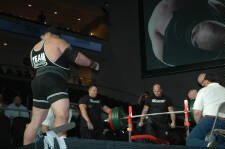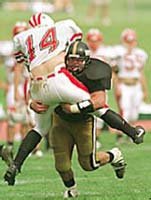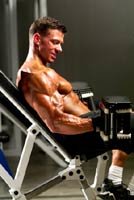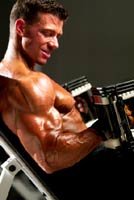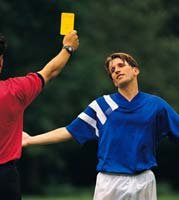
TOPIC: How Can You Develop Your Arms Accordingly To Your Sport?

The Question:
Arm strength plays a vital role in athletic performance. Whether you are throwing a ball, catching a ball, punching a person, swinging a bat or knocking someone over, arm movement is present. An athlete's arm development can differ depending on their sport. However, all athletes have incredible arms.
How can you develop your arms accordingly to your sport?
Which sport requires the most arm strength? Least arm strength?
Which sport requires the most arm speed? Least arm speed?
Bonus Question: Which athlete do you think had (or has) the best combination of arm strength and speed?
Show off your knowledge to the world!
The Winners:
- Ho_124 View Profile
- HBY18202 View Profile
-
Prizes:
-
1st place - 75 in store credit.
To use your credit, e-mail Will @ will@bodybuilding.com for more info.

1st Place - Ho_124
How can you develop your arms accordingly to your sport?
Contact This Author Here.

Any serious athlete must pay attention to this topic since weight training is something that will make you or break you. Let me give you an example. I used to be heavily into badminton and I knew a fellow player who started weight training. However his method of weight training was totally incorrect for badminton and as a result, after a year he started gaining too much weight and he became slower on the court, and as you can imagine his game suffered greatly.
This is a common mistake of many athletes just training for size to look good, but let me say that if you really want to excel in your sport you can't just have big muscles, you have to know how to train specifically for your sport.
When looking at training arms accordingly for a sport you have to look at different factors. These factors should guide you into the type of weight training you should do.
- What does your sport require your arms to do?
- What are the most important muscles required in my sport (Eg. Biceps, triceps, shoulders, forearms)
- Does your sport require more fast twitch, medium fast twitch, slow-twitch muscle fibers, or a mix (Does it require more power and strength, endurance, or a bit of each?)

1. Arm Requirements:
What does your sport require your arms to do?
This is the question you must consider when weight training specifically for your sport. This is more complicated than it sounds for example football. You need to consider what your arms need to be capable of doing when you're being hit, when you're hitting someone or tackling someone or sprinting up the field.
If you're into sprinting you need your arms to generate momentum and power for faster speeds. Once you have decided what your sport requires your arms to do it becomes easier to make decisions on all the other factors.

2. Muscles:
What are the most important muscles required in my sport?
This is super important to know because if you work the wrong muscles then you won't perform well at all. Once you know which muscles are involved you have to train them in a certain way and give them the attention they need. However this doesn't mean you should totally ignore the other muscles.
You still have to workout the other muscles of the arm which aren't involved as much for overall muscle balance. This will help you decide which muscles are most important:
Football & Rugby: Requires overall arm development for pulling, pushing, and tackling.
Martial Arts: Requires overall arm development for punches, uppercuts, hook punches etc.
Racquet Sports: requires shoulder and wrist development for swings and flicking of the wrist for certain shots.
Hockey: Requires overall arm development for checking, muscling through players, and making certain shots.
Running: Shoulder development for swinging the arms for momentum.
Soccer: Overall arm development is ideal because of the fact that players have to bust through other players and a strong set of arms would help. Also it would help during running to gain more momentum.
Basketball: Overall arm development would be nice since basketball players need to block players and break through defense so being strong would help.
Volleyball: The shoulder is extremely important for spikes since you need a powerful swinging motion.
Baseball: Well developed shoulders for swinging is important as well as total arm development to take the impact of the ball.

3. Muscle Fiber:
Does your sport require faster twitch, medium fast twitch, slow twitch muscle fibers, or a mix? (Does it require more power and strength, endurance, or a bit of each?)
There are three types of fibers:
- Type I which is slow twitch
- Type IIa which is medium fast twitch
- Type IIb which is fast twitch
| RELATED ARTICLE | ||
|
Different sports require more of one type of muscle fibers or a bit of both. Something that will help is deciding whether your sport is more strength and power oriented, endurance oriented or a mix such as strength and size. Each attribute such as strength or endurance have muscle fibers that are specifically designed for that attribute.
 Type I Fibers:
Type I Fibers:
These slow twitch-fibers cannot generate large amounts of power, but they are extremely resistant to fatigue. This is because they rely on oxygen for energy not ATP.
Because of their resistance to fatigue they are best for endurance sports such as speed skating, rowing, long distance running, and cycling.
| RELATED ARTICLE | ||
|
 Type IIa Fibers:
Type IIa Fibers:
These medium fast-twitch fibers are capable of large amounts of power, however they are more easily fatigued since they rely on ATP for energy. Think of these fibers as moderate power and moderate endurance.
These fibers are more for sports that require explosive bursts of power over a short period of time for example hockey, basketball and racquet sports.
 Type IIb Fibers:
Type IIb Fibers:
These fast-twitch fibers generate the most amount of force, however they are fatigued extremely easily because of their heavy reliance on ATP.
These fibers are only good for sports that require powerful bursts over a short time. These sports include sprinting, football, powerlifting and discus.
 Two Kinds Of Fibers:
Two Kinds Of Fibers:
-
Some sports require bits of both muscle fibers, for example badminton. Matches can last up to 45 minutes but players occasionally need that powerful burst of energy to make a shot. Therefore it becomes necessary to train two kinds of muscle fibers.
When you have figured out your sport requires a bit of two kinds of muscle fibers you have to decide how much more of a certain muscle fiber your sport requires. If your sport requires more type I muscle fibers then you train those fibers more, and less of the other.
If you train the wrong fibers your performance will suffer considerably. Take for example rowing. That requires extreme endurance since rowers can be racing for long periods of time. If they exclusively train the IIb (Fast twitch) fibers then they will fatigue way too early.
For sports that require a little bit of two kinds of muscle fibers:

Training Muscle Fibers:
How do you train muscle fibers specifically? (How do you train for strength, endurance, speed endurance etc?)
There are three main ways to do this which are through different repetitions, rest times and weight lifting techniques. Different repetitions hit certain muscle fibers more than the others and also the kinds of weight training techniques such as eccentrics are aimed more toward specific muscle fibers.
Repetitions, rest time, and weight training techniques - The key to hitting the muscle fiber correctly.
 Type I Fibers:
Type I Fibers:
These muscle fibers are best used for endurance and therefore the repetition range should be high. The high repetition range mimics the endurance aspect of a sport since each set will last longer. This will also cause minimal muscular growth and therefore you won't become bulky and slow which is another way it improves your endurance ability. The repetition range that should be used is 20+.
Because you're trying to mimic endurance rest times should be kept to a minimum. The times should be between 15-45 seconds.
Weight training techniques that work the endurance aspect are great to hit the type I fibers even more. One technique is loading up the weight so you have 50% of your maximum. Then complete 8 repetitions and load up more weight (5-10 lbs), do another 8 repetitions, and do it until you can't complete 8 reps. This is a great shocking technique for those type I fibers. Other good techniques are burn sets and same body part supersetting.
 Type IIa Fibers:
Type IIa Fibers:
-
These fibers are for speed endurance and therefore they are best hit with a repetition range of 8-12 repetitions. This rep range is ideal for working the IIa muscle fiber since your body requires quite a bit of power over a longer period of time. Because this job suits the IIa fibers the best it recruits those fibers.
-
Rest times should be also short since you want to build some resistance to fatigue, not purely explosive power. Rest times should be anywhere between 30 seconds to 1 minute and 15 seconds.
The best technique to work this type of muscle fiber is explosive or medium paced repetitions. As the name suggests the concentric part of a repetition is done quickly and the weight is lowered slowly.
 Type IIb Fibers:
Type IIb Fibers:
These fibers are purely for brute strength or for a short burst of power. The repetition range that hits these fibers best is a repetition range of 4-6 or 1-6 in some sports. Since so much power is required for a short time in these sets your body recruits the IIb fibers.
Rest times should be long so that ATP levels can rise again to provide the muscle with energy. If you take too little rest then your muscles won't have enough energy to complete the set and your workout will suffer.
Techniques that emphasize power and brute strength are great for isolating the IIb type fibers. The best technique would be eccentrics/negatives since it requires pure brute strength. Another great technique is Olympic lifts. These lifts emphasize strength and the explosiveness of the IIb fibers in multiple body parts including the arms. This is why so many sprinters and track athletes use these exercises.
| RELATED ARTICLE | ||
|
 Training Two Types Of Muscle Fibers:
Training Two Types Of Muscle Fibers:
One problem that many athletes run into is trying to train two types of muscle fibers because their sport requires it of them. Some people like to just have two different workouts; however the problem is that it is easier to overtrain because you will need more workouts to work each muscle fiber sufficiently. Also you can't spend as much individual time on each muscle fiber and therefore your progress will be slowed.
To solve the problem you should consider training the muscle fibers in phases meaning you devote a few months to training endurance and the next month to training speed/power endurance. This way your body is able to focus more time on developing one type of fiber which is an efficient way to train.
This is where you have to decide what your sport emphasizes more (The more you train one type of muscle fiber, the more percentage of your overall muscle it takes up). If it requires more endurance then have more months on the endurance phase rather than the phase that works power and speed endurance (type IIa fibers).
For example for badminton it requires endurance and speed occasionally. Therefore when I made my program I had 3-5 months of endurance (type I fiber) work and 1-2 months of speed endurance work (type IIa fiber). This way my body could focus totally on endurance for 4 months and speed endurance for two months.

Arm Strength:
Which sport requires the most arm strength? Least arm strength?
Obviously the sport that requires the most arm strength is powerlifting. The point of powerlifting is to lift as much weight as possible in one rep. Therefore the athletes train purely for brute strength and nothing else, it's the whole point of powerlifting training.
Some strength athletes are so strong that they can bench about 1,000 pounds (Gene Rychlak). Now I don't know of any other kind of athletes that could do that.
The sport that requires the least arm strength would probably be ping pong. I mean your shoulder has to have some endurance but really you don't need brute strength to hit a ping pong ball that weighs a few grams.

Arm Speed:
Which sport requires the most arm speed? Least arm speed?
Martial-arts definitely requires the most arm speed. You have to be able to punch so fast that your opponent can't react and you have to be able to block a punch in the blink of an eye. One example is Bruce Lee. One of his videos show him punching so fast that a person standing in front of him didn't even flinch or blink.
The sport that requires the least arm speed has got to be cycling. I mean most of the time your arms are just resting on the handles. The only time you really need a little bit of arm speed is turning but that's not hard at all. I mean honestly if you see a turn ahead and you can't turn the handle bars fast enough you're pretty sad.

Bonus Question:
Which athlete do you think had (or has) the best combination of arm strength and speed?
Bruce Lee has the best combination of arm speed and strength. The link above shows he was able to punch so fast that a person in front of him didn't even flinch or blink. Second is his amazing strength. He could do one finger push ups and he could send a guy a few feet back with a punch from only ONE INCH. People have described his kicks like being hit by cars!
References:

2nd Place - HBY18202
Contact This Author Here.

Arm strength plays a vital role in athletic performance. Whether you are throwing a ball, catching a ball, punching a person, swinging a bat or knocking someone over, arm movement is present. An athlete's arm development can differ depending on their sport. However, all athletes have incredible arms.
Without a doubt, arms are definitely one of the least neglected body parts. Regardless of sport, arms play a vital role in almost every aspect of movement. Arms seem to be more noticed in sports like football and basketball, more than your soccer and track, but when it all comes down to it, all sports notice positive gains through arms.
Some might say arms don't matter for athletes such as sprinters. This is completely false, because if you ever look at Michael Johnson's arms, you would know his arms aren't that toned just so he can look good. Different sports require different types of arms, and different roles in the same sport often require different sizes and shapes of arms. Obviously, a lineman and a wide receiver aren't going to be doing the same arm routine.
So in order to find out what ones arms need to be developed into, the athlete must decide what role they want to be a part of in their chose sport.

Arm Development:
How can you develop your arms accordingly to your sport?
Different sports will use different drills and tactics to ensure the best size and strength available to the athlete. For a football player, strength and mass might be the long-term goal, while a sprinter may need toned, cut arms. Either way, both individuals both have to put in work to achieve their goals.
 BFS Goal:
BFS Goal:
The Barbell Curl- This movement has often been called the "meat and potatoes" of the biceps. This exercise is preformed by allowing the bar to lower to the hip area, and the raising toward the chest while contracting the biceps.
Preacher Curls- This is basically performed the same way as the barbell curl, but with the arms are secured by a pad, so as to fully isolate the biceps.
Incline curls- This exercise is done while sitting on an incline bench, but with dumbbells. While sitting on the incline, extra stress is applied to the biceps, causing for a more intense lift.
Close-Grip Bench Press- I feel that this is the most intense tricep workout there is (running a close race with tricep flares), making it perfect for the main tricep exercise for this routine. It is preformed just like regular bench press, but with the hands closer together, so that the triceps do the work and not the chest.
Dips- These can be done with or without weight. If being toned was my priority, then I would just do my bodyweight with as many reps as possible. If I wanted to increase my tricep strength quickly, I would do weighted dips in sets. This exercise is executed by placing the hands on parallel bars, and lowering oneself down, and rising back up by pressing upon the bars with the triceps.
Lying Tricep Extensions- The reason I choose the over regular tricep extensions is because by laying down, you don't allow yourself to cheat as much, making for a much more effective lift. This lift is performed by allowing the weight to come down towards the individuals head, and the raising the weight back up above oneself. If the lifter keeps their elbows in, then this left should prove to be a challenge.
For the athlete who is looking for bigger and stronger arms, a more hardcore arm program may be implemented. Many high schools football teams, including mine, continue to use the BFS (Bigger, Faster, Stronger) system year after year. This system is designed so that the athlete does exactly what it says, bigger faster stronger.
BFS takes one core workout, and circulates other workouts around your main lift for the day. So if you had a chest day, and your main lift was flat barbell bench, then you would use lifts such as flyes and dips as your auxiliary lifts. The great thing about this program is that it can be a great tool for any athlete.
Doing more reps will allow an athlete who wants to tone up and become leaner to do so, and heavier, lower reps would make the individual stronger and bigger.
With that being said, if becoming bigger, faster and stronger was my goal then my arm workout would go as follows:
 Growth Goal:
Growth Goal:
- Incline Hammer Curls- This are done with holding the dumbbells vertical rather than horizontal (so as not to do a dumbbell curl), so while holding the dumbbells waist level and vertical, you raise them up and pull into your shoulders.
As stated earlier, the size and strength of the arms are dependent upon the number of reps applied, and the weight being used. This routine can be used for either target (toned and cut, or strength and mass), as long as the weight and reps are applied correctly in order to achieve the athletes goals.
If all out growth in terms of size was what was targeted, then the brachialis may be a muscle you want to target. This muscle is located under the bicep, and is supposed to be trained directly after the bicep workout according to the latest brachialis article from Bodybuilding.com.
Arnold Schwarzenegger was a big advocate of training the brachialis because he felt that it was a big component of building massive biceps. Some great exercises to train the brachialis are:

Arm Strength:
Which sport requires the most arm strength? Least arm strength?
I feel that powerlifting easily wins this contest. In terms of strength, nobody needs a set of strong arms more than a powerlifter. Arms are needed in almost every lift that a powerlifter does. You're going to have a weak deadlift if your arms aren't up to par.
The same goes for bench as well as cleans. Everyone knows barbell bench is a chest workout, but the arms are the "car" of the workout while the chest is the "engine." Without either the lift just doesn't happen.
In my opinion, the sport that requires the least arm strength is soccer. Not to take anything away from soccer players, but arm strength just really isn't needed. With soccer, besides using arms to pump for speed, the arms aren't even used (excluding the goalie).
So much emphasis is placed upon the leg strength and speed, that arms are often neglected in soccer, though it's never really noticed. With soccer requiring more stamina than strength, it should be no surprise that this sport was picked as the sport with least arm strength.
| RELATED POLL | |||
|
|||

Arm Speed:
Which sport requires the most arm speed? Least arm speed?
I think the sport that requires the most overall arm strength would have to be baseball. Some could say football but everyone on the baseball diamond has to be able to throw, not just a single player. If I had to be more detailed, then I would have to say that the pitcher has to have the most arm speed out of any athlete.
Their job is to throw up and sometimes over 100 mph with 95% of their total energy. This can be extremely tiring, and with all the torque placed upon the pitcher's arm, injuries are fairly common. With shoulder and elbow surgery being some of the most common because of the stress that is placed upon these areas.
Speed which is needed the most is often what causes these injuries. Improper technique along with overuse is mainly what causes the stress, which is where the arm exercises come into play. The better shape the arm is in, the less chance for injury, which is true with any sport.
In my honest opinion, the sport that requires the least arm speed would have to be powerlifting. While needing more strength than any sport, speed is not a big concern. Nobody cares how fast your curls are, as long as you have good form and can perform is correctly. Your cleans don't have to snap fast if you can place get it up on your chest. Speed is not something to totally neglect in this sport, but it's not a vital part of powerlifting.
| RELATED POLL | |||
|
|||

Bonus Question:
Which athlete do you think had (or has) the best combination of arm strength and speed?
Brett Favre would have to be my pick for overall arm strength and speed. His arm has to be in condition, because he holds the record of 221 consecutive starts, the most in the NFL. Favre has always been known for his arm strength and speed, because he's able to throw the ball hard and accurately with opposing players coming after him causing him to make a quick throw.
He's done it consecutively for years, and with another season coming quickly, I'm sure he'll show why he's held that record. With his overall combination of arm strength and speed, Brett Favre would easily be my pick for overall arm ability.






